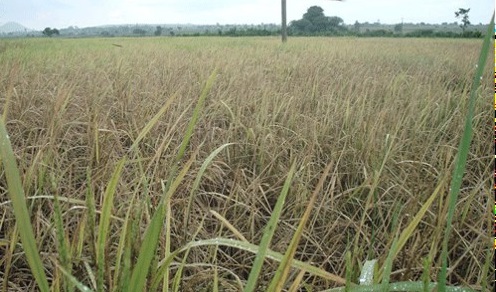
Eggs are laid in longitudinal rows within the leaf midribs. On an average, a female hopper lays 150 - 300 eggs. Eggs are similar to those of BPH but have a longer, more pointed egg plug. Eggs laid in batch are not joined at the tip. The eggs hatch in about 8-12 days.
Nymphs are white to a strongly mottled dark grey or black and white in colour.
They reach adulthood in 12-17 days passing through five instars. Total life cycle is completed in about 29 to 54 days. Adult hopper has a prominent white band between the junctions of the wings. The body is creamy white with the mesonotum and abdomen black dorsally and the legs ochraceous brown.

WBPH occurs in both upland and wetland rice ecosystems. WBPH prefers a young crop and often produces long migratory forms before the plants flower. Both adults and nymphs suck the sap primarily at the base of the rice plants resulting in yellowing of the lower leaves, reduced vigor and stunting of plants. Severely attacked seedlings wilt and eventually die. If the infestation is at the panicle initiation stage, the number of grains and the panicle length decrease. But when attacked later, during the maturation period, grains do not fill and ripening is delayed. When hoppers are present in large numbers late in crop growth stage they are seen infesting the flag leaves and panicles. Gravid females cause additional damage by making oviposition punctures in leaf sheaths. Feeding points and wounds caused by egg deposition may later become potential sites for the invasion of bacteria and fungi. Moreover, the honeydew produced by the hoppers serves as a medium for mold growth.
Grow resistant varieties like Cotton dora sannalu (MTU 1010), Vijetha (MTU 1001), Chaitanya (MTU 2067), Krishnaveni (MTU 2077), Surya (BPT 4358), Vajram (MTU 5249), Pratibha (MTU 5293), Deepti (MTU 4870), Godavari (MTU 1032).
Leave alleyways - While planting, for every 2 meters, leave 30 cm alleyway.
Drain stagnant water from the field immediately and allow sunlight and wind to pass through the base of the plants.
Alternate wetting and drying helps in reducing the planthopper population build up.
Rice crop harbours diverse species of natural enemies.
Predators like mirid bugs, spiders and coccinellids that prey on eggs of planthoppers, egg parasitoids like Anagrus, Oligosita species and aquatic predators like Microvelia and Mesovelia help in keeping the planthopper population under check. Hence, conservation of these natueal enemies is very important in rice.
Grow crops like Marigold, Lady's finger, cowpea, pillipesara, Jute, coriander, Sesamum and saunf on rice bunds to provide nectar and pollen for natural enemies to increase their longevity and aid in faster multiplication.
Do not apply synthetic pyrethroids like deltamethrn, cypermethrin, lamda cyhalothrin, either alone or in combination of other insecticides as they cause resurgence of planthoppers.
When there are 10 - 15 BPH/WBPH per plant, spray the following insecticides per acre.
Apply Triflumezopyrim 10.6% SC @ 94 ml/acre between 45 - 60 DAT only once.
In case of severe incidence of planthoppers, apply Pymetrozine 50 WP @ 120 g/acre (or) Dinotefuran 20 WG @ 80 g/acre (or) Acephate 75 WP @ 250 g/acre (or) Glamor 80 WP @ 50 g/acre
Do not repeat or use the same insecticide.
While spraying, nozzle should be directed at the basal portion of the plants.
Application with power sprayer is preferable.